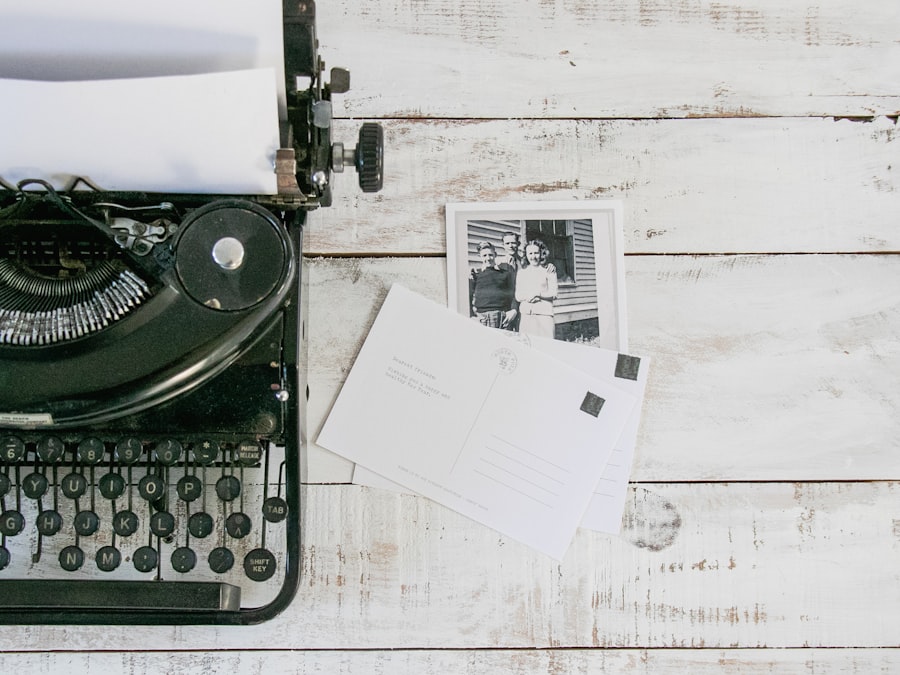
Mysterious encounters have long captivated the human imagination, serving as a fertile ground for storytelling across cultures and generations. These encounters often involve unexpected events or interactions that challenge the characters’ understanding of reality, leading to profound transformations or revelations. The allure of the unknown, coupled with the thrill of suspense, creates a rich tapestry for writers to explore.
Whether it’s a chance meeting with a stranger in a fog-laden alley or an inexplicable phenomenon that defies logic, these moments can evoke a sense of wonder and fear, compelling readers to delve deeper into the narrative. The essence of a mysterious encounter lies in its ability to evoke curiosity and provoke thought. It invites readers to question their perceptions and consider the possibilities that lie beyond the ordinary.
This genre thrives on ambiguity, often leaving characters and readers alike grappling with unanswered questions. The beauty of such encounters is that they can occur in any setting, from the mundane to the fantastical, allowing for a diverse range of interpretations and emotional responses. As we explore the various elements that contribute to crafting compelling mysterious encounters, we will uncover the techniques that can elevate a simple narrative into an unforgettable experience.
Key Takeaways
- Mysterious encounters can captivate readers and add an element of intrigue to a story.
- The setting plays a crucial role in creating an atmosphere of mystery and suspense in mysterious encounters.
- Well-developed characters with complex motivations can add depth and interest to mysterious encounters.
- Plot twists and suspenseful moments are essential for keeping readers engaged in mysterious encounters.
- Symbolism and foreshadowing can add layers of meaning and anticipation to mysterious encounters.
The Power of Setting in Mysterious Encounters
Creating an Atmosphere of Suspense
For instance, a dilapidated mansion, shrouded in mist and surrounded by gnarled trees, can evoke feelings of dread and anticipation. The creaking floorboards and flickering candlelight create an ambiance ripe for unexpected revelations.
Reflecting Character Emotions
The setting can reflect the internal struggles of characters, mirroring their emotional states and heightening the tension within the narrative. A character grappling with feelings of isolation may find themselves in a desolate landscape, where the vast emptiness amplifies their sense of loneliness. Conversely, a vibrant marketplace bustling with activity might symbolize a character’s desire for connection and belonging.
Integrating Setting into Mysterious Encounters
By thoughtfully integrating setting into mysterious encounters, writers can create layers of meaning that resonate with readers on multiple levels.
Character Development in Mysterious Encounters

Character development is crucial in mysterious encounters, as it allows readers to form emotional connections with the individuals navigating these enigmatic situations. Characters should be multi-dimensional, possessing distinct motivations, fears, and desires that drive their actions. For example, a seemingly ordinary protagonist who stumbles upon a hidden truth may initially react with skepticism or fear.
As the story unfolds, their journey can lead to personal growth, forcing them to confront their beliefs and assumptions about the world around them. In addition to the protagonist, secondary characters can also play significant roles in shaping the narrative. A mysterious stranger who appears at a critical moment can serve as a catalyst for change, challenging the protagonist’s worldview and prompting them to take risks they might otherwise avoid.
The interplay between characters adds depth to the story, as their relationships evolve in response to the unfolding mystery. By investing time in character development, writers can create compelling dynamics that enhance the overall impact of mysterious encounters.
Plot Twists and Suspense in Mysterious Encounters
| Encounter | Plot Twist | Suspense Level |
|---|---|---|
| Haunted House | Ghosts are actually trying to help | High |
| Alien Abduction | Aliens are peaceful researchers | Medium |
| Bigfoot Sighting | Bigfoot is a protector of the forest | Low |
Plot twists are essential elements in mysterious encounters, serving to surprise readers and keep them engaged. A well-executed twist can turn expectations on their head, revealing hidden truths that alter the course of the narrative. For instance, a character who appears to be an ally may ultimately be revealed as an antagonist, forcing both the protagonist and readers to reevaluate their understanding of events.
Such twists not only heighten suspense but also encourage readers to actively participate in piecing together clues throughout the story. Suspense is intricately woven into the fabric of mysterious encounters, creating an atmosphere charged with tension and uncertainty. Writers can build suspense through pacing, carefully controlling the flow of information to maintain intrigue.
By revealing details gradually and strategically withholding key information, authors can keep readers on edge, eager to uncover what lies ahead. The use of cliffhangers at chapter endings or unexpected interruptions during critical moments can further amplify suspense, ensuring that readers remain invested in the outcome.
Using Symbolism and Foreshadowing in Mysterious Encounters
Symbolism serves as a powerful tool in mysterious encounters, allowing writers to imbue their narratives with deeper meanings that resonate beyond the surface level. Objects or motifs can represent larger themes or concepts, enriching the reader’s experience. For example, a recurring image of a broken clock might symbolize lost time or missed opportunities, subtly hinting at the protagonist’s internal struggles as they navigate their mysterious circumstances.
Such symbols can create connections between characters’ journeys and broader existential questions.
By planting subtle hints or clues early in the narrative, writers can create an underlying sense of inevitability that culminates in significant revelations later on.
This technique not only engages readers but also encourages them to reflect on earlier events as they gain new insights into the unfolding mystery. A seemingly innocuous detail—a character’s offhand remark or an unusual occurrence—can take on new significance when viewed through the lens of later developments.
Crafting Dialogue in Mysterious Encounters

Dialogue is a vital component of storytelling that can reveal character motivations and advance the plot while maintaining an air of mystery. In mysterious encounters, dialogue should be carefully crafted to reflect the tension and uncertainty inherent in such situations. Characters may speak in riddles or use ambiguous language that leaves room for interpretation, mirroring the complexity of their circumstances.
This not only adds depth to their interactions but also invites readers to engage more actively with the text. Moreover, dialogue can serve as a vehicle for exposition without feeling forced or contrived. Characters may share snippets of information about their pasts or hint at hidden agendas through casual conversation.
This technique allows writers to convey essential background details while maintaining an air of intrigue. The interplay between characters’ spoken words and unspoken thoughts can create layers of meaning that enrich the narrative and keep readers guessing about each character’s true intentions.
Incorporating Supernatural Elements in Mysterious Encounters
The incorporation of supernatural elements can elevate mysterious encounters from mere intrigue to otherworldly experiences that challenge characters’ perceptions of reality. Supernatural occurrences—such as ghostly apparitions, inexplicable phenomena, or time travel—can serve as catalysts for character development and plot progression. For instance, a protagonist who encounters a spirit from their past may be forced to confront unresolved issues or guilt that has haunted them for years.
These elements also allow for exploration of themes such as fate versus free will or the nature of existence itself. By introducing supernatural forces into mysterious encounters, writers can delve into philosophical questions that resonate with readers on a deeper level. The blending of reality and fantasy creates an atmosphere rich with possibilities, inviting readers to suspend disbelief and immerse themselves fully in the narrative.
Conclusion and Final Tips for Writing Mysterious Encounters
Writing mysterious encounters requires careful consideration of various elements that contribute to an engaging narrative. From setting and character development to plot twists and supernatural elements, each component plays a crucial role in crafting an experience that captivates readers’ imaginations. As you embark on your writing journey, remember to embrace ambiguity and allow your characters to navigate uncertainty while remaining true to their motivations.
Additionally, don’t shy away from experimenting with different narrative structures or perspectives to enhance your storytelling. Consider how shifting points of view might alter readers’ perceptions or how nonlinear timelines could add complexity to your plot. Ultimately, writing mysterious encounters is about creating an immersive experience that invites readers to explore the unknown alongside your characters while leaving them with lingering questions long after they turn the final page.
If you’re looking for inspiration for your short stories, you may want to check out the collection of ebooks available at Sersea Ink. These ebooks cover a wide range of genres and topics, providing plenty of material to spark your creativity. Additionally, you can also explore the world of song lyrics at Sersea Ink for another source of writing prompts. And if you’re interested in diving into longer narratives, the selection of books at Sersea Ink may offer even more ideas for your next short story.
FAQs
What are writing prompts for short stories?
Writing prompts for short stories are specific ideas, phrases, or images that are designed to inspire writers and help them generate new story ideas. They can be used as a starting point for a short story or as a way to overcome writer’s block.
How do writing prompts help with short story writing?
Writing prompts can help spark creativity and imagination, provide a starting point for a story, and challenge writers to think outside their usual writing habits. They can also help writers overcome writer’s block by providing a new direction or idea to explore.
Where can I find writing prompts for short stories?
Writing prompts for short stories can be found in various places, including online writing communities, writing prompt books, creative writing websites, and social media platforms. Writers can also create their own prompts based on their interests and experiences.
How do I use writing prompts for short stories?
To use a writing prompt for a short story, writers can start by reading the prompt and allowing their imagination to explore different possibilities. They can then brainstorm ideas, develop characters, and create a plot based on the prompt. Writers can also use multiple prompts to create a more complex story.
Are there different types of writing prompts for short stories?
Yes, there are different types of writing prompts for short stories, including image-based prompts, word or phrase prompts, situation prompts, and character prompts. Each type of prompt can inspire different aspects of a short story, such as setting, conflict, or character development.



